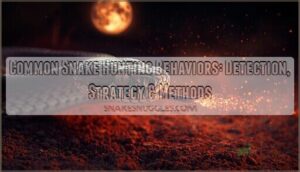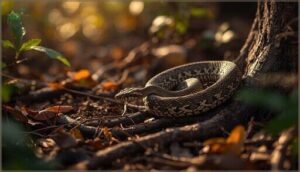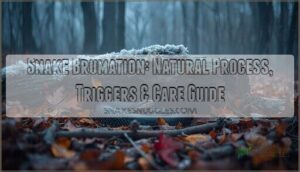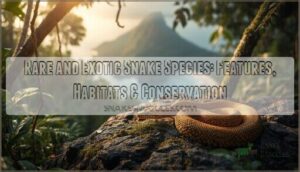This site is supported by our readers. We may earn a commission, at no cost to you, if you purchase through links.
A rattlesnake doesn’t just strike at random. It waits motionless for hours, tracking your body heat with specialized pits that detect temperature changes as tiny as 0.003°C. This level of precision allows snakes to hunt effectively even in complete darkness.
Understanding common snake hunting behaviors reveals how these reptiles combine multiple sensory systems to locate, track, and capture prey with striking efficiency. From the flickering tongue that samples chemical trails with 92% accuracy to the lightning-fast constriction that triggers cardiac arrest in under a minute, each behavior has a specific purpose in the predatory sequence.
You’ll discover how snakes adapt their strategies based on habitat, whether they rely on venom or constriction, and what their body language reveals about strike readiness.
Table Of Contents
Key Takeaways
- Snakes combine multiple sensory systems—including heat-sensing pits that detect temperature changes as tiny as 0.003°C, tongue flicking with 92% scent trail accuracy, and vibration detection through their jaws—to locate and track prey with exceptional precision even in complete darkness.
- Hunting strategies split into two main approaches: ambush predators use camouflage and motionless waiting (sometimes for hours) to reduce detection by up to 65%, while active foragers constantly move and scent-track their prey despite higher energy costs.
- Venomous snakes achieve over 90% immobilization success through specialized toxin delivery, while constrictors apply crushing pressure up to 175 kPa that triggers cardiac arrest in prey within 60 seconds through calculated coiling behavior.
- Environmental factors like habitat type, terrain complexity, and vegetation density directly shape snake hunting tactics—timber rattlesnakes gain 80% better foraging success in mature forests, while desert species adapt locomotion and conserve energy through lower metabolic rates in arid conditions.
How Snakes Detect and Track Prey
Snakes don’t rely on just one sense to find their next meal. Instead, they’ve evolved a fascinating toolkit that combines chemical detection, thermal imaging, and vibration sensing to track prey with impressive precision.
Let’s look at the three main ways snakes detect and zero in on their targets.
Tongue Flicking and Scent Trails
Flicking its forked tongue, a snake samples the air with striking precision. Each fork collects chemical particles independently, allowing you to witness nature’s elegant solution for directional scent detection. The tongue delivers these samples to Jacobson’s organ, which processes chemical gradients at concentrations as low as 1 part per billion. Snakes utilize their venom, specifically using disintegrins, to help relocate their prey after a strike.
- Scent trail accuracy: Snakes following prey trails succeed 92% of the time in controlled environments
- Flicking frequency: Tongue flicks increase 200% when tracking wounded prey through strike-induced chemosensory searching
- Sensory integration: Combining chemical and visual cues raises prey detection success to 93%
- Olfactory tracking: Chemical trail following remains effective up to 48 hours after prey passage
Heat-Sensing Pits and Vibration Detection
Beyond scent tracking, pit vipers and some boas possess striking sensory systems that transform prey detection. Their pit organs detect infrared radiation thresholds as low as 10.75 µW/cm², sensing temperature changes of just 0.003°C—perfect for spotting warm-blooded meals in darkness. Snakes utilize these organs to boost their thermosensory-driven foraging, improving their hunting success.
| Sensory Feature | Detection Capability | Hunting Advantage |
|---|---|---|
| Heat-sensing pits | Prey heat at 60-80 cm distance | Nocturnal ambush predator precision |
| Vibration frequency range | Ground sounds below 150 Hz | Multi-modal integration with thermal cues |
| Pit organ anatomy | 7,000 infrared-sensitive nerve endings | Evolutionary advantages in low-light environments |
Your jaw also transmits ground vibrations to inner ears, detecting approaching prey through substrate movements. These multi-modal hunting strategies showcase millions of years of refinement, giving snakes exceptional advantages over prey in thermally complex habitats where thermoregulation processes create detectable heat signatures.
Visual Cues and Movement Recognition
While thermal and chemical sensory systems excel in specific conditions, your visual apparatus plays a surprisingly complex role in prey detection. Motion sensitivity dominates snake hunting strategies—certain species detect shapes as tiny as 2-3 mm at 30 cm distance.
Peripheral vision maintains over 60% prey recognition accuracy even off-center. Evolutionary adaptations include specialized retinal cells boosting hunting success by 70% for swift-moving targets, proving vision complements other sensory systems remarkably well.
Ambush Versus Active Hunting Strategies
Snakes don’t all hunt the same way. Some prefer to sit still and wait for prey to wander close, while others actively search for their next meal.
Understanding these two main strategies will help you recognize how different species approach hunting in their natural environments.
Camouflage and Stealth Tactics
Ambush predators depend on camouflage techniques that make them invisible to both prey and threats. Blotched patterns reduce detection probability by up to 65%, while some vipers use zig-zag designs that cut predator attacks by 30%. Pattern adaptation allows you to see how snakes match their surroundings perfectly.
Behavioral modifications include staying motionless for hours, and temporal advantages come from hunting during twilight when sensory deception works best for predator evasion.
Active Foraging and Scent Tracking
Unlike sit-and-wait hunters, active foraging snakes use constant movement and scent tracking to find meals. You’ll notice these species rely on chemosensory information gathered through rapid tongue flicking, which greatly boosts detection rates.
Tracking efficiency depends on several factors:
- Scent trail fidelity in varied weather conditions
- Metabolic foraging costs limiting hunt duration
- Sensory integration combining chemical and visual cues
- Species variation in tongue-flick rates
- Habitat complexity affecting pursuit success
This hunting strategy demands higher energy but yields consistent prey encounters.
Adaptive Hunting Based on Habitat
When you explore diverse ecosystems, you’ll find snakes adjust their hunting strategies to match their surroundings. Timber rattlesnakes select ambush sites in mature forests where prey traffic peaks, while aquatic species show 65% higher underwater hunting success. Arboreal snakes prefer complex forest canopies for ambush predation, and desert dwellers like sidewinders bury themselves in sand, demonstrating striking habitat-driven adaptations across terrestrial and aquatic environments.
Venomous and Constricting Hunting Methods
Snakes have evolved two primary methods to overpower their prey: venom and constriction. Each approach comes with its own set of advantages and risks, shaping how different species hunt and survive.
Let’s look at how these methods work and which snakes use them most effectively.
Venom Delivery and Effects on Prey
Venomous snakes have perfected the art of prey capture through specialized toxin delivery systems. When fangs inject venom composition rich in neurotoxins and metalloproteinases, immobilization success rates exceed 90% in controlled studies.
These physiological effects vary with toxin diversity—neurotoxins trigger rapid paralysis while hemotoxins disrupt blood flow.
This hunting strategy minimizes struggle and injury, showcasing venom’s profound ecological impact on predator-prey dynamics.
Constriction Techniques and Prey Subduing
When you watch a constrictor wrap around its prey, you’re seeing one of nature’s most efficient prey capture methods. Constrictors apply constriction pressure ranging from 5 to 175 kPa through coiling behavior, triggering cardiac arrest in under 60 seconds.
Constrictors apply crushing pressure up to 175 kPa, triggering cardiac arrest in prey within 60 seconds through coiling behavior
These constriction hunting techniques demonstrate how snake prey capture methods have evolved—larger prey requires more coils and longer subduing duration, with spinal fracture occasionally occurring during the process.
Specialized Behaviors in Unique Species
Some snakes have turned specialized hunting into an art form. You’ll find aquatic prey specialists, ambush predator behavior masters, and unusual snake adaptations that reveal just how creative evolution can be.
Here are five noteworthy predatory snake species with unique hunting strategies:
- Fordonia leucobalia pins hard-shelled crabs with its chin rather than fangs, demonstrating dietary innovations in aquatic environments.
- Gerarda prevostiana hunts soft-shelled crabs four times its jaw width, showcasing extreme snake adaptations for hunting.
- Pit vipers detect temperature changes as tiny as 0.003°C through sensory specializations, striking with 85% accuracy in darkness.
- Boiga irregularis relies on visual arboreal capture tactics during twilight hours when canopy prey is most active.
- African Banded Cobras deploy venom within 30 cm of prey, paralyzing victims in under 30 seconds through precise venom deployment.
Communication and Body Language in Hunting
Snakes don’t vocalize like other predators, but they communicate plenty during the hunt. Their bodies tell a story through tail rattles, coiled postures, and invisible chemical messages that drift through the air.
Let’s look at three key ways snakes use body language and signals while tracking and capturing prey.
Tail Movements and Warning Signals
You might assume tail movements are just for balance, but they’re powerful communication tools. When threatened, snakes vibrate their tails at impressive frequencies—rattlesnakes hit up to 91 rattles per second.
This signal modulation functions as predator deterrence, with contextual variability based on temperature and distance.
These behavioral cues showcase evolutionary aspects refined over millions of years, transforming simple body language into elaborate warning signals that keep both predators and snakes safer.
Chemical Signals and Pheromones
Beyond visible warning signals, you’ll discover that chemical signals and pheromones drive snake predation through intricate scent tracking. These hunting strategies rely on VNO mechanisms that decode pheromone composition in prey trails.
- Chemosensory tracking guides rattlesnakes to envenomated prey with impressive accuracy
- Intraspecific cues help snakes distinguish competitors from potential meals
- Environmental scent manipulation directly impacts hunting success
Your understanding of snake scent tracking reveals how chemical communication shapes every hunting encounter.
Body Postures During Predation
While chemical cues guide snakes to prey, their body language also reveals strike readiness through distinct defensive postures. A striking posture features an S-shaped neck curve and raised head—seen in 85% of rattlesnake attacks.
During a stalking approach, snakes maintain elevated heads with tongue-flicking exceeding 25 flicks per minute. Coiling contact happens fast, with constrictors forming tight loops around prey in under five seconds in 90% of successful subduing postures.
Environmental Factors Shaping Hunting Behaviors
A snake’s surroundings shape how it hunts more than you might think. Desert heat, dense jungle canopy, or rocky terrain all push snakes toward different strategies for catching their next meal.
Let’s look at the main environmental factors that influence these fascinating behaviors.
Habitat Influence on Hunting Strategies
Where you find a snake tells you how it hunts. Timber rattlesnakes in mature forests gain 80% better foraging success because prey availability peaks there. Climate effects shape energy use, while vegetation density and terrain complexity determine whether a species becomes an ambush expert or active tracker. Habitat disturbance like drought forces desert environment specialists and aquatic hunters to adapt quickly or face decline.
- Forest snakes select sites with taller canopies where chipmunk encounters increase dramatically
- Desert environment species conserve energy through lower metabolic rates in arid conditions
- Aquatic and arboreal hunters adjust tactics when habitat structure changes
Pattern Adaptations for Camouflage
Habitat shapes snake patterns through disruptive coloration and edge enhancement. You’ll notice blotched patterns on ambush hunters that break up body outlines against complex backgrounds, while longitudinal stripes help active foragers vanish during rapid movement.
Mimicry patterns let harmless species copy venomous coral snakes for protection.
Pattern evolution is sensitive to visual context—vipers with zig-zag designs reduce detection rates considerably compared to solid-colored species in field studies.
Locomotion Techniques for Different Terrains
Terrain shapes snake locomotion through distinct muscle coordination patterns. You’ll see sidewinders crossing desert sand at 18 miles per hour while minimizing heat contact, or constrictors using concertina movements in tight burrows despite higher energetic costs.
Adaptive locomotion techniques reflect evolutionary pressures:
- Lateral undulation achieves speed efficiency on rough ground
- Arboreal species employ ventral flexion for vertical climbing
- Burrowing specialists swim through sand using powerful waves
Frequently Asked Questions (FAQs)
How often do snakes need to eat?
Your snake might go weeks between meals—most adults eat every one to two weeks, while juveniles need food weekly.
Fasting ability and feeding frequency depend on species variation, prey preferences, and energy expenditure.
Can snakes hunt successfully in complete darkness?
Yes, many snakes hunt successfully in complete darkness using infrared detection, nocturnal adaptations, and sensory compensation. Pit vipers, pythons, and boas excel through thermal imaging, while others rely on chemical cues and vibration sensitivity.
Do snakes hunt differently during breeding season?
During mating season, hunting strategies shift dramatically. Snakes increase foraging activity, expand their territory, and boost reproductive caloric intake.
Seasonal temperature influence drives these predatory behavior changes, altering typical snake behavior patterns.
What happens when snakes encounter oversized prey?
When you see a snake face oversized prey, behavioral changes kick in. Swallowing limitations may trigger regurgitation risks or abandonment.
Energetic costs soar, affecting survival strategies and predatory behavior, sometimes causing mortality incidence despite constricting efforts.
How do snakes choose between multiple prey?
When faced with multiple targets, you’ll find snakes rely on sensory cues and prey vulnerability rather than deliberate selection.
Foraging trade-offs balance energetic reward against predation risk, guiding which prey triggers their predatory behavior first.
Conclusion
A coiled snake embodies patience perfected through millions of years. You’ve now traced the evolutionary blueprint behind common snake hunting behaviors—from chemical detection through tongue flicks to the calculated strike that ends in seconds.
These aren’t random instincts but finely tuned survival mechanisms shaped by habitat, prey type, and sensory specialization.
Understanding this predatory precision doesn’t just satisfy curiosity. It prepares you with knowledge that bridges fear and respect for these misunderstood hunters.
- https://pmc.ncbi.nlm.nih.gov/articles/PMC10630157/
- https://theconversation.com/the-ultimate-in-stealth-puff-adders-employ-camouflage-at-every-level-53316
- https://www.inaturalist.org/projects/snake-predation-records/journal/80059-4-456-snakes-and-counting
- https://www.herpconbio.org/Volume_18/Issue_3/Hensley_Hensley_2023.pdf
- https://www.sciencedirect.com/science/article/abs/pii/S0168159121002379












